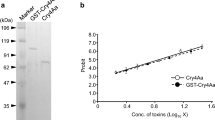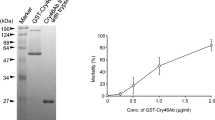Abstract
Cry46Ab from Bacillus thuringiensis TK-E6 is a new mosquitocidal toxin with an aerolysin-type architecture, and it is expected to be used as a novel bioinsecticide. Cry46Ab acts as a functional pore-forming toxin, and characteristics of the resulting channel pores, including ion selectivity, have been analyzed. However, the relationship between channel-pore ion selectivity and insecticidal activity remains to be elucidated. To clarify the effects of charged amino acid residues on the ion permeability of channel-pores and the resulting insecticidal activity, in the present study, we constructed Cry46Ab mutants in which a charged amino acid residue within a putative transmembrane β-hairpin region was replaced with an oppositely charged residue. Bioassays using Culex pipiens mosquito larvae revealed that the mosquitocidal activity was altered by the mutation. A K155E Cry46Ab mutant exhibited toxicity apparently higher than that of wild-type Cry46Ab, but the E159K and E163K mutants exhibited decreased toxicity. Ions selectivity measurements demonstrated that the channel pores formed by both wild-type and mutant Cry46Abs were cation selective, and their cation preference was also similar. However, the degree of cation selectivity was apparently higher in channel pores formed by the K155E mutant, and reduced selectivity was observed with the E159K and E163K mutants. Our data suggest that channel-pore cation selectivity is a major determinant of Cry46Ab mosquitocidal activity and that cation selectivity can be controlled via mutagenesis targeting the transmembrane β-hairpin region.
Key points
• Cry46Ab mutants were constructed by targeting the putative transmembrane β-hairpin region.
• Charged residues within the β-hairpin control the flux of ions through channel pores.
• Channel-pore cation selectivity is correlated with insecticidal activity.








Similar content being viewed by others
Availability of data and material
Not applicable
References
Akiba T, Abe Y, Kitada S, Kusaka Y, Ito A, Ichimatsu T, Katayama H, Akao T, Higuchi K, Mizuki E, Ohba M, Kanai R, Harata K (2009) Crystal structure of the parasporin-2 Bacillus thuringiensis toxin that recognizes cancer cells. J Mol Biol 386:121–133. https://doi.org/10.1016/j.jmb.2008.12.002
Almond BD, Dean DH (1993) Structural stability of Bacillus thuringiensis delta-endotoxin homolog-scanning mutants determined by susceptibility to proteases. Appl Environ Microbiol 59:2442–2448
Benz R, Popoff MR (2018) Clostridium perfringens enterotoxin: The toxin forms highly cation-selective channels in lipid bilayers. Toxins (Basel) 10:E341. https://doi.org/10.3390/toxins10090341
Chakraborty T, Schmid A, Notermans S, Benz R (1990) Aerolysin of Aeromonas sobria: evidence for formation of ion-permeable channels and comparison with alpha-toxin of Staphylococcus aureus. Infect Immun 58:2127–2132
Cole AR, Gibert M, Popoff M, Moss DS, Titball RW, Basak AK (2004) Clostridium perfringens epsilon-toxin shows structural similarity to the pore-forming toxin aerolysin. Nat Struct Mol Biol 11:797–798. https://doi.org/10.1038/nsmb804
Crickmore N, Berry C, Panneerselvam S, Mishra R, Connor TR, Bonning BC (2020) A structure-based nomenclature for Bacillus thuringiensis and other bacteria-derived pesticidal proteins. J Invertebr Pathol.:107438. https://doi.org/10.1016/j.jip.2020.107438
de Maagd RA, Bravo A, Berry C, Crickmore N, Schnepf HE (2003) Structure, diversity, and evolution of protein toxins from spore-forming entomopathogenic bacteria. Annu Rev Genet 37:409–433
Degiacomi MT, Lacovache I, Pernot L, Chami M, Kudryashev M, Stahlberg H, van der Goot FG, dal Peraro M (2013) Molecular assembly of the aerolysin pore reveals a swirling membrane-insertion mechanism. Nat Chem Biol 9:623–629. https://doi.org/10.1038/nchembio.1312
Finney DJ (1971) Probit analysis, 3rd edn. Cambridge University Press, London
Gazit E, La Rocca P, Sansom MS, Shai Y (1998) The structure and organization within the membrane of the helices composing the pore-forming domain of Bacillus thuringiensis delta-endotoxin are consistent with an “umbrella-like” structure of the pore. Proc Natl Acad Sci U S A 95:12289–12294. https://doi.org/10.1073/pnas.95.21.12289
Hayakawa T, Kanagawa R, Kotani Y, Yamagiwa M, Kimura M, Yamane Y, Takebe S, Sakai H (2007) Parasporin-2Ab, a newly isolated cytotoxic crystal protein from Bacillus thuringiensis. Curr Microbiol 55:278–283. https://doi.org/10.1007/s00284-013-0301-1
Hayakawa T, Sakakibara A, Ueda S, Azuma Y, Ide T, Takebe S (2017) Cry46Ab from Bacillus thuringiensis TK-E6 is a new mosquitocidal toxin with aerolysin-type architecture. Insect Biochem Mol Biol 87:100–106. https://doi.org/10.1016/j.ibmb.2017.06.015
Howlader MTH, Kagawa Y, Sakai H, Hayakawa T (2009) Biological properties of loop-replaced mutants of Bacillus thuringiensis mosquitocidal Cry4Aa. J Biosci Bioeng 108:179–283. https://doi.org/10.1016/j.jbiosc.2009.03.016
Iacovache I, Paumard P, Scheib H, Lesieur C, Sakai N, Matile S, Parker MW, van der Goot FG (2006) A rivet model for channel formation by aerolysin-like pore-forming toxins. EMBO J 25:457–466. https://doi.org/10.1038/sj.emboj.7600959
Kim HS, Yamashita S, Akao T, Saitoh H, Higuchi K, Park YS, Mizuki E, Ohba M (2000) In vitro cytotoxicity of non-cyt inclusion proteins of a Bacillus thuringiensis isolate against human cells, including cancer cells. J Appl Microbiol 89:16–23. https://doi.org/10.1046/j.1365-2672.2000.01087.x
Kitadokoro K, Nishimura K, Kamitani S, Fukui-Miyazaki A, Toshima H, Abe H, Kamata Y, Sugita-Konishi Y, Yamamoto S, Karatani H, Horiguchi Y (2011) Crystal structure of Clostridium perfringens enterotoxin displays features of beta-pore-forming toxins. J Biol Chem 286:19549–19555. https://doi.org/10.1074/jbc.M111.228478
Knowles BH (1994) Mechanism of action of Bacillus thuringiensis insecticidal δ-endotoxins. Adv Insect Physiol 24:275–308
Knowles BH, Ellar DJ (1987) Colloid-osmotic lysis is a general feature of the mechanism of action of Bacillus thuringiensis δ-endotoxins with different insect specificity. Biochim Biophys Acta 924:507–518
Mancheño JM, Tateno H, Goldstein IJ, Hermoso JA (2004) Crystallization and preliminary crystallographic analysis of a novel haemolytic lectin from the mushroom Laetiporus sulphureus. Acta Crystallogr D Biol Crystallogr 60:1139–1141. https://doi.org/10.1107/S0907444904007991
Miles G, Movileanu L, Bayley H (2002) Subunit composition of a bicomponent toxin: staphylococcal leukocidin forms an octameric transmembrane pore. Protein Sci 11:894–902. https://doi.org/10.1110/ps.4360102
Parker MW, Buckley JT, Postma JP, Tucker AD, Leonard K, Pattus F, Tsernoglou D (1994) Structure of Aeromonas toxin proaerolysin in its water-soluble and membrane-channel states. Nature 367:292–295. https://doi.org/10.1038/367292a0
Petit L, Maier E, Gibert M, Popoff MR, Benz R (2001) Clostridium perfringens epsilon toxin induces a rapid change of cell membrane permeability to ions and forms channels in artificial lipid bilayers. J Biol Chem 276:15736–15740. https://doi.org/10.1074/jbc.M010412200
Rossjohn J, Feil SC, McKinstry WJ, Tsernoglou D, van der Goot G, Buckley JT, Parker MW (1998) Aerolysin-a paradigm for membrane insertion of beta-sheet protein toxins? J Struct Biol 121:92–100. https://doi.org/10.1006/jsbi.1997.3947
Sakakibara A, Takebe S, Ide T, Hayakawa T (2019) Characterization of the channel-pores formed by Bacillus thuringiensis Cry46Ab toxin in planar lipid bilayers. Appl Entomol Zool 54:389–398. https://doi.org/10.1007/s13355-019-00635-z
Schnepf E, Crickmore N, Van Rie J, Lereclus D, Baum J, Feitelson J, Zeigler DR, Dean DH (1998) Bacillus thuringiensis and its pesticidal crystal proteins. Microbiol Mol Biol Rev 62:775–806
Song L, Hobaugh MR, Shustak C, Cheley S, Bayley H, Gouaux JE (1996) Structure of staphylococcal alpha-hemolysin, a heptameric transmembrane pore. Science 274:1859–1866. https://doi.org/10.1126/science.274.5294.1859
Xu C, Wang BC, Yu Z, Sun M (2014) Structural insights into Bacillus thuringiensis Cry, Cyt and parasporin toxins. Toxins (Basel) 6:2732–2770. https://doi.org/10.3390/toxins6092732
Acknowledgments
Eggs of C. pipiens were kindly supplied by the Research and Development Laboratory at Dainihon Jochugiku Co., Ltd., Osaka, Japan.
Funding
The present work was supported in part by a research grant from the OSHIMO foundation (2019) and a JSPS KAKENHI grant (number JP18K05675).
Author information
Authors and Affiliations
Contributions
TH and TI conceived and designed research. TH and SH constructed mutants and analyzed their biological activity. TH, MM, MA, and TI contributed electrophysiologic experiments. TH, MM, and TI analyzed data. TH wrote the manuscript. All authors read and approved the manuscript.
Corresponding author
Ethics declarations
Conflict of interest
The authors declare that they have no conflict of interest.
Ethical approval
This article does not describe any studies with human participants or animals performed by any of the authors.
Consent to participate
All authors approved participation.
Consent for publication
All authors approved publishing of this article.
Code availability
Not applicable.
Additional information
Publisher’s note
Springer Nature remains neutral with regard to jurisdictional claims in published maps and institutional affiliations.
Rights and permissions
About this article
Cite this article
Hayakawa, T., Miyazaki, M., Harada, S. et al. Channel-pore cation selectivity is a major determinant of Bacillus thuringiensis Cry46Ab mosquitocidal activity. Appl Microbiol Biotechnol 104, 8789–8799 (2020). https://doi.org/10.1007/s00253-020-10893-5
Received:
Revised:
Accepted:
Published:
Issue Date:
DOI: https://doi.org/10.1007/s00253-020-10893-5




